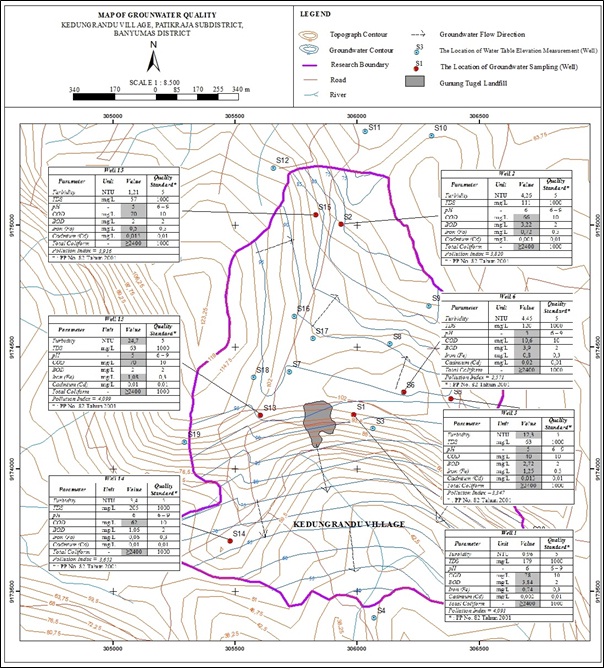Evaluation of Groundwater Quality Status Around Gunung Tugel Landfill In Kedungrandu Village, Patikraja District, Banyumas Regency, Central Java, Indonesia.
DOI:
https://doi.org/10.25299/jgeet.2021.6.1.5112Keywords:
groundwater, Groundwater Quality Status, Pollution IndexAbstract
Gunung Tugel Disposal Site (GTDS) is one of the final land disposal sites established in 1983 in the Banyumas Regency, and it operates with an open-dumping system. In this system, the base of the disposal site is neither coated with an impermeable layer nor equipped with leachate collection and drainage channels, for which leachate can percolate through the soil and pollute groundwater. In March 2016, GTDS was closed because its capacity had been exceeded. The closure of GTDS was not followed by appropriate waste and environmental management, prompting the formation of leachate that can contaminate the environment, particularly groundwater. This research set out to identify the leachate quality of GTDS, assess the groundwater quality, and determine the groundwater quality status around the disposal site. It employed a field survey and mapping to plot and display the groundwater well points in the study area, laboratory analysis to identify the groundwater quality, and pollution index calculation to determine the groundwater quality status. The groundwater samples were tested in the laboratory for their physical (turbidity and TDS), chemical (pH, COD, BOD, iron (Fe), cadmium (Cd)), and biological properties (total coliform). The results showed that the cadmium (Cd) levels in several groundwater well points had exceeded the quality standards. Based on the analysis and calculation results, the groundwater quality status in the study area is mildly contaminated, with the pollution index ranging between 2.571 and 4.099.
Downloads
References
Abou Zakhem, B., Hafez, R., 2015. Heavy metal pollution index for groundwater quality assessment in Damascus Oasis, Syria. Environ. Earth Sci. 73, 6591–6600.
Ardani, R., Yari, A.R., Fahiminia, M., Hashemi, S., Fahiminia, V., Saberi Bidgoli, M., 2015. Assessment of Influence of Landfill Leachate on Groundwater Quality: A Case Study Albourz Landfill (Qom, Iran). Arch. Hyg. Sci. 4, 13–21.
Aziz, H.A., Zahari, M.S.M., Bashir, M.J.K., Hung, Y.T., 2013. Groundwater contamination at landfill site, Handbook of Environment and Waste Management: Volume 2: Land and Groundwater Pollution Control.
Badr, E., Agrama, A., 2011. Heavy metals in drinking water and human health , Egypt.
Egbueri, J.C., 2020. Groundwater quality assessment using pollution index of groundwater (PIG), ecological risk index (ERI) and hierarchical cluster analysis (HCA): A case study. Groundw. Sustain. Dev. 10, 100292.
Oyiboka, I.J., 2014. Effects of Landfill Sites on Groundwater Quality in Igando, Alimosho Local Government Area, lagos State. University of South Africa.
Przydatek, G., Kanownik, W., 2019. Impact of small municipal solid waste landfill on groundwater quality. Environ. Monit. Assess. 191, 1–14.
Wahyuning, I., Muryani, E., 2018. Kajian Kualitas Air Lindi Terhadap Kualitas Air Tanah Di Sekitar Tpa (Tempat Pemrosesan Akhir) Sampah Jetis, Desa Pakem, Kecamatan Gebang, Purworejo, Jawa Tengah. J. Tanah dan Air (Soil Water Journal) 15, 1–9.
Widodo, T., Budiastuti, M.T.S., Komariah, K., 2019. Water Quality and Pollution Index in Grenjeng River, Boyolali Regency, Indonesia. Caraka Tani J. Sustain. Agric. 34, 150.

Downloads
Published
Issue
Section
License
Copyright @2019. This is an open-access article distributed under the terms of the Creative Commons Attribution-ShareAlike 4.0 International License which permits unrestricted use, distribution, and reproduction in any medium. Copyrights of all materials published in JGEET are freely available without charge to users or / institution. Users are allowed to read, download, copy, distribute, search, or link to full-text articles in this journal without asking by giving appropriate credit, provide a link to the license, and indicate if changes were made. All of the remix, transform, or build upon the material must distribute the contributions under the same license as the original.










